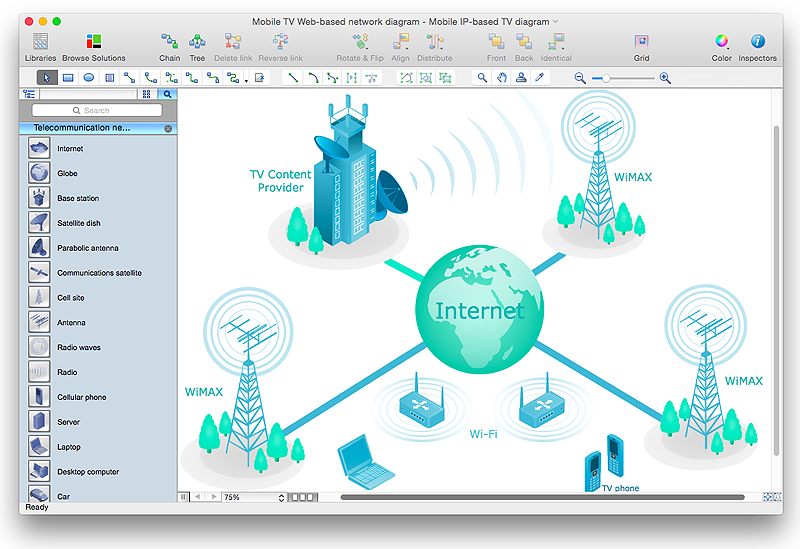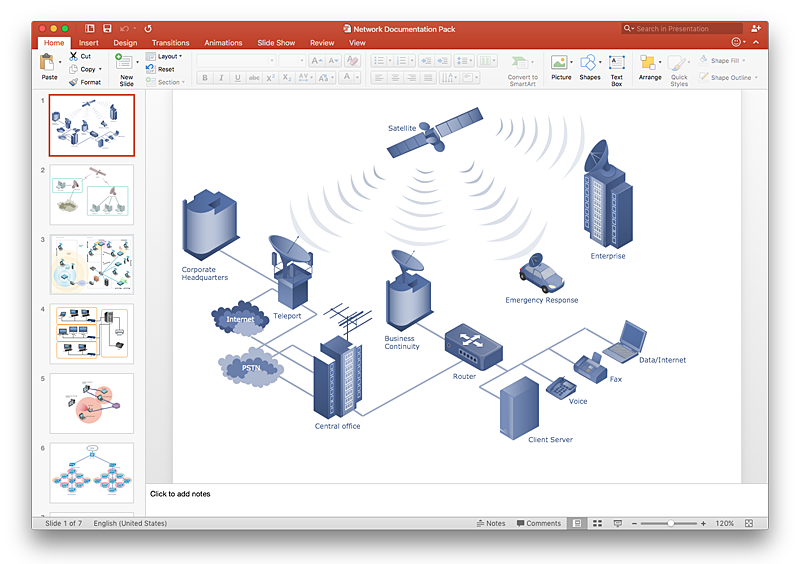 Telecommunication Network Diagrams
Telecommunication Network Diagrams
Telecommunication Network Diagrams solution extends ConceptDraw PRO software with samples, templates, and great collection of vector stencils to help the specialists in a field of networks and telecommunications, as well as other users to create Computer systems networking and Telecommunication network diagrams for various fields, to organize the work of call centers, to design the GPRS networks and GPS navigational systems, mobile, satellite and hybrid communication networks, to construct the mobile TV networks and wireless broadband networks.
HelpDesk
How to Create a Telecommunication Network Diagram in ConceptDraw PRO
Telecommunication network diagram displays components and connections in a telecommunication network: how they are interacted between each other and with end-users. Telecommunication network diagrams usually created by system engineers for planning telecom networks. Also they may be useful for a network management. Telecom network diagram visualizes the level of security and user access to certain eqipment and data within a current network. Telecom network diagram can be used to identify weak points of an entire network or a part of it. ConceptDraw PRO allows you to draw a simple and clear Telecommunication Network diagrams.HelpDesk
How to Add a Telecommunication Network Diagram to a PowerPoint Presentation Using ConceptDraw PRO
Telecommunication network diagram represents a system consisting of computers, servers, telecommunication devices, switches, satellites, wireless transmitters, antennas, cables, etc., that link a set of remote nodes. It is also describes a telephone exchange, that connects calls between landlines. ConceptDraw PRO allows you to easily create telecommunication network diagrams and then make a PowerPoint Presentation from your network documentation in a few clicks. Telecommunication network diagrams are used to show components and connections in a telecommunications network: how they are interacted between each other and with end-users. The PowerPoint presentation on concept of telecom network can be very informative and helpful. ConceptDraw PRO allows you to make a MS PowerPoint Presentation from your telecommunication network diagrams in a few clicks.
 ConceptDraw Solution Park
ConceptDraw Solution Park
ConceptDraw Solution Park collects graphic extensions, examples and learning materials
 Block Diagrams
Block Diagrams
Block diagrams solution extends ConceptDraw PRO software with templates, samples and libraries of vector stencils for drawing the block diagrams.
 Event-driven Process Chain Diagrams
Event-driven Process Chain Diagrams
Event-driven Process Chain (EPC) Diagram is a type of flowchart widely used for modeling in business engineering and reengineering, business process improvement, and analysis. EPC method was developed within the Architecture of Integrated Information Systems (ARIS) framework.
 Interactive Voice Response Diagrams
Interactive Voice Response Diagrams
Interactive Voice Response Diagrams solution extends ConceptDraw PRO v10 software with samples, templates and libraries of ready-to-use vector stencils that help create Interactive Voice Response (IVR) diagrams illustrating in details a work of interactive voice response system, the IVR system’s logical and physical structure, Voice-over-Internet Protocol (VoIP) diagrams, and Action VoIP diagrams with representing voice actions on them, to visualize how the computers interact with callers through voice recognition and dual-tone multi-frequency signaling (DTMF) keypad inputs.
- Telecommunication Network Diagrams | Process Flowchart | Block ...
- Telecommunication Network Diagrams | Mobile Tv Block Diagram ...
- Explain Block Diagram Of Network Management With Diagram
- Explain The Process Of Business Communication With Block Diagram
- UML Block Diagram | Telecommunication Network Diagrams ...
- Draw And Explain The Block Diagram Of Wireless Network
- Cisco Network Diagrams | Telecommunication Network Diagrams ...
- Draw And Explain Block Diagram Of A Simple Pc Based Network
- Explain With The Help Of A Block Diagram The Basic Conponent Of
- Explain Computer Networking With Block Diagram In Pdf
- Telecommunication Network Diagrams | 2g With Block Diag And ...
- UML Block Diagram | Telecommunication Network Diagrams | Basic ...
- Explain In Detail About Block Diagram Of Satellite Based Data ...
- Telecommunication Network Diagrams | Design elements ...
- Block Diagram | Process Flowchart | Engineering | Draw Block ...
- Sample Network Block Diagram
- Telecommunication Network Diagrams | Block Diagrams | Cisco ...
- Telecommunication Network Diagrams | How to Add a Block ...
- Telecommunication Network Diagrams | Wireless Networks | Basic ...
- Telecommunication Network Diagrams | Storage area networks ...

